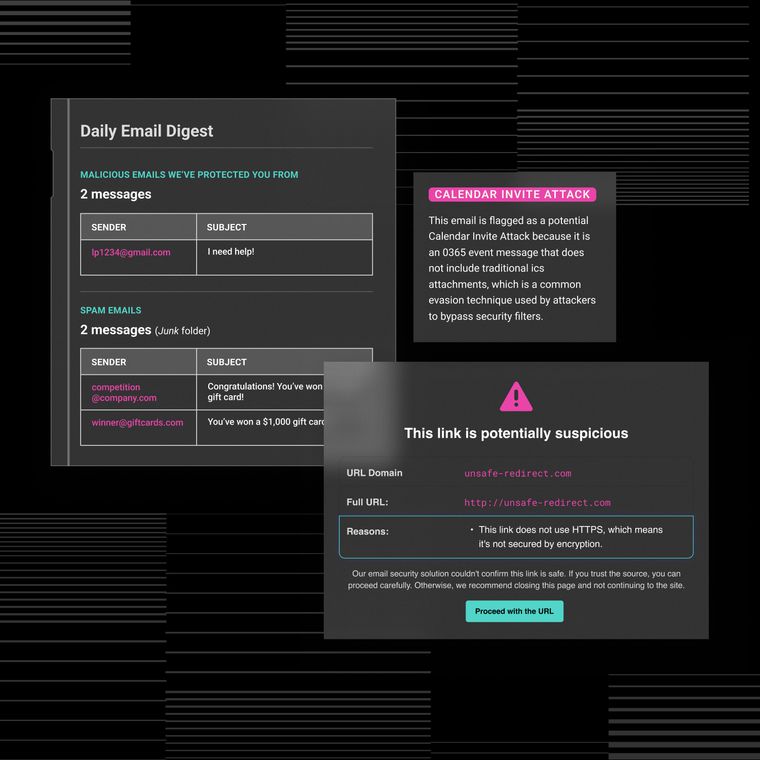7 Critical SaaS Security Risks Every Organization Must Address
Understand significant SaaS security risks plus expert mitigation tactics your team can act on. Read the article to know more.
July 3, 2025
SaaS environments represent prime targets for cybercriminals because they store vast amounts of sensitive data, including payment card details, personally identifiable information, and confidential business records. This concentration of valuable data makes SaaS security a critical priority for every organization.
SaaS security encompasses the strategic practices organizations deploy to safeguard their digital assets within SaaS architectures. The security framework operates on a shared-responsibility model where you manage access controls, data protection, and user permissions while your SaaS vendor secures the underlying infrastructure and platform code.
This guide examines the seven critical SaaS security risks and provides actionable strategies to eliminate each threat.
1. Protect Your Data From Leaks and Loss
In multi-tenant SaaS platforms, shared files often remain accessible long after their intended use. Many files retain broad access permissions, including "anyone with the link" sharing that bypasses normal authentication. When employees leave, external partners change roles, or sharing links circulate beyond intended recipients, sensitive data becomes accessible to unauthorized individuals.
Data loss prevention (DLP) in SaaS requires a proactive approach that assumes some level of data exposure is inevitable. The goal shifts from preventing all data sharing to ensuring that sharing occurs under controlled conditions with appropriate monitoring and automatic expiration controls.
Take the following actions to prevent unauthorized data leaks:
Deploy SaaS-specific DLP tools to scan shared content and automatically block unauthorized exposures
Implement customer-managed encryption keys where vendors support this capability for additional protection
Replace permanent "anyone with the link" access with time-limited, recipient-specific permissions
Conduct quarterly audits to identify and remediate stale data exposures and unused external shares
Configure real-time alerts for sensitive data sharing activities and large-volume downloads
Effective data protection requires treating it as an ongoing discipline rather than a one-time setup. Organizations that maintain continuous oversight significantly reduce unauthorized exposure risks.
2. Stop Unauthorized Access and Account Takeovers
Account takeover attacks represent one of the most direct threats to SaaS security. Unlike infrastructure attacks requiring technical exploitation, account takeovers often succeed through credential theft, social engineering, or weak authentication controls. AI-powered phishing campaigns now create compelling, personalized attacks that traditional security awareness training struggles to address.
Former employee accounts present another critical vulnerability. Organizations often struggle with timely access revocation, particularly for SaaS applications that don't integrate with central identity management systems. These dormant accounts may retain access to sensitive business information while receiving less monitoring attention.
Do the following to reduce the risk of account takeovers:
Implement multi-factor authentication (MFA) across all SaaS applications, including service and administrative accounts
Deploy conditional access policies that require additional verification based on risk indicators like unusual locations or new devices
Automate account lifecycle management by connecting HR systems directly to SaaS access controls
Centralize authentication logs in your SIEM system for comprehensive monitoring and correlation analysis
Conduct regular privilege reviews to enforce least-privilege principles and remove unnecessary access
Deploy advanced email security controls to prevent credential harvesting attempts from reaching users
Strong access controls create multiple barriers that attackers must overcome. Comprehensive identity and access management significantly reduces both the likelihood and impact of successful account compromises.
3. Fix Dangerous Default Settings
SaaS applications typically ship with default configurations optimized for rapid adoption rather than security. Vendors prioritize ease of use and immediate functionality, often enabling broad sharing permissions, public access options, and extensive integration capabilities that create significant security risks.
Misconfigurations represent a leading cause of cloud security incidents, with many breaches traced to settings that administrators either overlooked or incorrectly assumed were secure. The shared responsibility model places configuration security entirely within customer control, making proactive hardening essential.
Here are some steps you can take to fix dangerous default settings:
Conduct comprehensive configuration audits for each SaaS application against established security baselines
Deploy SaaS Security Posture Management tools to monitor continuously and automatically flag dangerous misconfigurations
Establish least-privilege access as your foundational principle, removing default administrative access that isn't actively used
Systematically remove third-party integrations that no longer serve clear business purposes or have excessive access
Configure real-time alerts for configuration changes that could impact security posture
Document and maintain security baselines for consistent configuration across similar applications
Proactive configuration management transforms SaaS security from a reactive incident response to a preventive risk reduction approach. Systematic hardening significantly reduces exposure to preventable incidents.
4. Discover and Control Shadow IT
Employees can easily sign up for SaaS applications using corporate email addresses, creating accounts that operate outside IT oversight and security controls. This democratization of software procurement benefits productivity but creates significant blind spots in security monitoring and policy enforcement.
The challenge extends beyond simple application discovery. Many shadow IT deployments involve data sharing, integration with approved systems, and collaboration with external partners, creating complex data flows that security teams cannot monitor or protect.
Here are some steps to control shadow IT deployments:
Deploy Cloud Access Security Broker (CASB) tools to provide comprehensive visibility into all SaaS usage across your organization
Establish streamlined approval processes for legitimate business tools that reduce incentives for shadow IT adoption
Require Single Sign-On integration for all approved applications to centralize authentication and enable rapid access revocation
Monitor network traffic and DNS queries to identify new SaaS connections and unusual usage patterns
Develop user education programs that explain shadow IT risks while providing clear alternatives and efficient request processes
Maintain detailed inventories of all authorized applications with clear usage policies and acceptable data types
Effective shadow IT management strikes a balance between security requirements and legitimate business needs. Organizations that provide clear alternatives and efficient approval processes achieve better outcomes than those with restrictive policies alone.
5. Secure Your API Connections
API security in SaaS environments presents unique challenges because traditional network security controls don't apply to cloud-based integrations. Organizations often grant API access with excessive permissions during initial setup, creating powerful attack vectors that can be exploited if authentication credentials are compromised.
OAuth token compromise represents a particularly serious threat because these tokens often have long expiration periods and may not be subject to the same security controls as user accounts. Unlike user sessions that may trigger alerts for unusual behavior, compromised API tokens can operate continuously within normal parameters, often without detection.
Here's how to secure your API connections:
Conduct thorough audits of all integrations to identify and eliminate connections with unnecessary access privileges
Implement systematic API key and OAuth token rotation on regular schedules, with a maximum 90-day lifespan
Deploy API gateways that authenticate and authorize every request regardless of source or apparent legitimacy
Establish comprehensive monitoring for API activity patterns that could indicate compromise or automated abuse
Require formal security reviews for all new integrations before deployment, including partner security assessments
Schedule regular penetration testing specifically targeting API endpoints and integration vulnerabilities
Strong API security requires treating every integration as a potential threat vector while maintaining operational flexibility. Comprehensive API controls significantly reduce exposure to integration-based attacks.
6. Manage Third-Party Vendor Risks
Third-party risk management extends beyond direct vendor relationships to include subprocessors, infrastructure providers, and service partners that support your SaaS applications. Most SaaS vendors rely on numerous relationships for core functionality, and each of these relationships introduces potential vulnerabilities, despite having no direct contractual connection.
Supply chain attacks often target smaller, less secure vendors that provide services to multiple large organizations, creating opportunities to compromise numerous targets through a single successful breach. The complexity of modern SaaS ecosystems makes it challenging to assess and monitor these extended risk relationships.
Do the following to prevent vendor fraud risks:
Send comprehensive security questionnaires to all vendors covering both direct security controls and subprocessor management
Verify vendor security certifications through independent validation rather than accepting self-reported compliance claims
Include "flow-down" clauses in contracts requiring your security standards to apply to all subprocessors handling your data
Implement continuous vendor risk monitoring using threat intelligence feeds to track security incidents affecting your vendor ecosystem
Conduct formal annual vendor reviews assessing ongoing security posture and compliance with contractual requirements
Maintain detailed inventories mapping all third and fourth-party relationships to specific data types and business processes
Effective third-party risk management requires ongoing attention and systematic processes rather than one-time assessments. Treating vendor risk as a continuous discipline achieves better security outcomes.
7. Gain Visibility Into Your SaaS Activity
Limited visibility into SaaS activities creates fundamental challenges for security monitoring, incident detection, and compliance reporting. Many SaaS providers maintain audit logs for only short periods, creating significant gaps in forensic capabilities when security incidents require investigation over longer timeframes.
Different vendors implement varying log formats, retention policies, and event detail levels, making it challenging to correlate activities across multiple SaaS applications. This fragmentation hampers security teams' ability to detect sophisticated attacks that might span multiple platforms.
Protect your activity visibility by following the actions below:
Implement centralized log forwarding from all SaaS applications to your Security Information and Event Management (SIEM) system or dedicated data lake
Extend log retention periods significantly beyond vendor defaults to support comprehensive investigations and compliance requirements
Configure automated alerts for suspicious activities including unusual data modifications, bulk operations, and after-hours access
Implement structured logging requirements that enable automated processing and correlation across your entire SaaS environment
Deploy advanced analytics and machine learning to identify subtle patterns and anomalies that traditional monitoring might miss
Establish secure log archive procedures that protect historical audit data from tampering while ensuring investigative availability
Comprehensive SaaS visibility requires treating log management as a critical security capability rather than a compliance afterthought. A robust logging infrastructure enables better security outcomes and effective incident response.
Protect Your Organization Against SaaS Security Risks
Implementing these seven critical security measures requires both strategic planning and tactical execution. The complexity of modern SaaS environments means that manual oversight alone cannot provide adequate protection against evolving threats.
Ready to see how advanced SaaS security monitoring works in practice? Request an Abnormal demo to experience how AI-powered behavioral analysis can detect the sophisticated threats that traditional security tools miss.
Related Posts
Get the Latest Email Security Insights
Subscribe to our newsletter to receive updates on the latest attacks and new trends in the email threat landscape.


